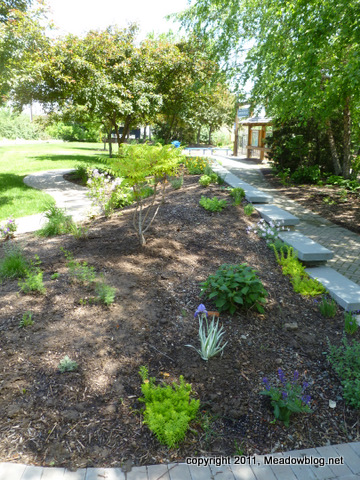 If you've been wondering what the new garden is by the entrance to the marsh Discovery Trail, wonder no more.
If you've been wondering what the new garden is by the entrance to the marsh Discovery Trail, wonder no more.
It is our new Sensory Garden.
Here are the details, courtesy of Lisa Cameron of the NJMC's Parks Department:
This most recent feature at DeKorte Park is specifically designed to appeal to the senses.
It is also intended to bring a diversity of plants within reach of visitors with limited mobility.
You may think of gardens primary as things to look at, but they can also be smelled, touched, tasted and even heard. There are more than fifty varieties of plants in this small area, all selected for their sensory appeal. More will be added. Name tags – some in Braille – will be added as well.
More text follows.
Sight
Color, visual texture, form, movement, light, and shadow stimulate the sense of sight. Contrasts of these elements add to the sensory experience. Flowers are a glorious source of color but leaves also display a great range colors and patterns, and last all season long.
Smell
The sense of smell is deeply emotional and associative. A fragrance can evoke long-buried memories. Some plants release their fragrance into the air with the heat of the sun, while others release their scent only when crushed or brushed against. Please handle plants gently.
Touch
Tactile delights can be found in soft flowers, fuzzy leaves, springy moss, rough bark, succulent leaves and prickly seed pods. Some plants offer a variety of textures – think of the rose with its buttery petals and thorny stems. Please handle plants gently.
Taste
Maybe you have a garden at home and are used eating the fruits, leaves and roots of culinary plants. Other plants that we don’t think of as food are actually quite tasty – nasturtium, for instance is a common annual whose leaves and flowers add peppery taste to salads.
* The NJMC does not use any pesticides in the garden. However, you should never eat from any plant unless you are thoroughly familiar with it and certain you are not allergic.
Sound
Grasses rustle. Small branches knock together. Seed pods make natural maracas. Leaves crunch underfoot. In this garden, sound comes mostly from wind blowing through the various-textured leaves. Compare the sound of the tall reeds to the sound of the softer grasses. Listen for animal sounds as well. Fountains and wind chimes are other things that add sound to a garden.
(Thanks, Lisa!)
